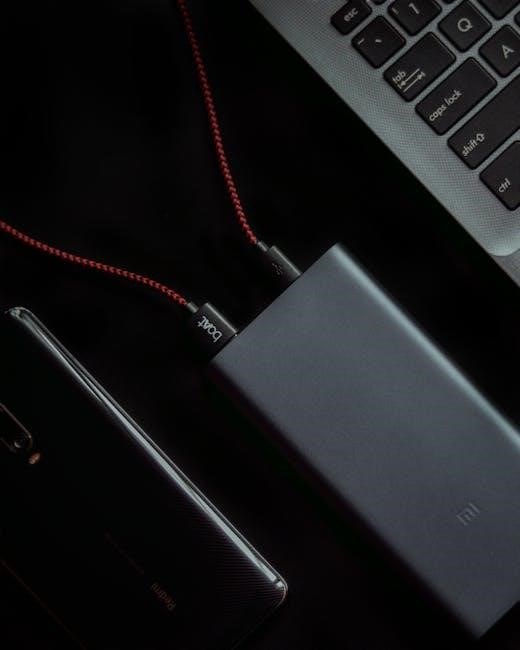Proper battery cable sizing is crucial for safety, efficiency, and performance. This guide provides a comprehensive approach to selecting the right cable size for your needs, ensuring reliable power delivery and preventing potential hazards caused by undersizing or oversizing cables.
1.1 Why Battery Cable Size Matters
Battery cable size plays a critical role in ensuring safe and efficient power delivery. Properly sized cables minimize voltage drop, reducing the risk of overheating and electrical failures. Undersized cables can overheat, leading to fire hazards and reduced system performance, while oversizing may increase costs unnecessarily. The right cable size ensures optimal current flow, maintaining system reliability and longevity. Incorrect sizing can also lead to premature battery degradation and potential safety risks. Understanding the importance of correct cable sizing is essential for designing and maintaining reliable electrical systems. This guide helps you make informed decisions to avoid these issues and ensure your setup operates efficiently and safely.
1.2 Key Factors in Choosing the Right Battery Cable
When selecting a battery cable, several factors must be considered to ensure optimal performance and safety. Voltage and current requirements are primary, as they determine the necessary cable thickness to handle the load without overheating. Cable length also plays a role, as longer cables require thicker gauges to minimize voltage drop. The type of material, such as copper or aluminum, affects conductivity and durability. Environmental conditions, like temperature and exposure to chemicals, must also be accounted for. Proper sizing ensures efficient power delivery, prevents system damage, and reduces fire hazards. Using a battery cable size chart can simplify the process by providing a reference for gauge selection based on these factors.

How to Choose the Right Battery Cable Size
Selecting the right battery cable size involves calculating current, voltage, and cable length to ensure safe and efficient power delivery, minimizing voltage drop and preventing overheating.

2.1 Step-by-Step Guide to Selecting Battery Cables
To select the right battery cables, start by determining the total current and voltage required by your system. Measure the distance between the battery and the load to account for voltage drop. Use an online wire size calculator or a battery cable size chart to find the appropriate gauge based on these factors. Consider the maximum operating temperature and environmental conditions. Finally, choose cables made from durable materials, such as copper or aluminum, to ensure reliability and safety. Proper sizing ensures efficient power delivery and minimizes risks of overheating or system failure.
2.2 Using a Battery Cable Size Chart for Accurate Selection
A battery cable size chart is an essential tool for ensuring accurate selection. These charts typically display wire gauges based on current, voltage, and cable length. To use one effectively, determine your system’s maximum current draw and voltage, then measure the cable length. Refer to the chart to find the recommended gauge that can handle the load without excessive voltage drop. This method ensures safety, efficiency, and optimal performance. Always cross-reference with the manufacturer’s specifications for precise compatibility. By following the chart, you can avoid common sizing errors and ensure reliable power delivery in your application.

Common Mistakes to Avoid When Sizing Battery Cables
Common mistakes include undersizing cables, leading to overheating, and oversizing, which increases costs. Always calculate voltage drop and consider environmental factors to ensure optimal performance and safety.
3.1 Risks of Undersizing Your Battery Cables
Undersizing battery cables can lead to significant risks, including overheating, voltage drop, and reduced system efficiency. Excessive resistance in smaller cables causes power loss, potentially damaging equipment and posing fire hazards. Additionally, undersized cables may fail under high current conditions, disrupting power supply and requiring costly repairs. Always ensure cables are appropriately sized for the intended current and voltage to maintain reliability and safety. Proper sizing prevents premature cable degradation and ensures optimal performance across all connected devices. Regular inspections and adherence to sizing charts are essential to avoid these risks and guarantee a stable electrical connection.
3.2 Dangers of Oversizing Your Battery Cables
Oversizing battery cables can lead to unnecessary costs and installation challenges. While larger cables can handle higher currents, they are heavier, less flexible, and more expensive. This can complicate routing and mounting, potentially causing mechanical stress on connections. Additionally, oversized cables may not heat dissipate efficiently, especially in confined spaces, which can lead to premature degradation. However, the primary risk lies in the potential for overconfidence in the system’s reliability, which may result in neglecting proper maintenance or inspections.

Furthermore, oversized cables may not always provide the expected performance benefits, as voltage drop can still occur if the cable length or material is not appropriately matched to the application. Always aim for a balanced approach to cable sizing to ensure safety, efficiency, and cost-effectiveness.

Calculating the Correct Battery Cable Size
Accurate cable sizing involves considering voltage drop, current flow, and cable length. Use online calculators or charts to determine the optimal size for safe, efficient power delivery.
4.1 Understanding Voltage Drop and Its Impact on Cable Size
Voltage drop occurs when electrical energy is lost as heat in a cable, reducing the voltage available to the load. It is influenced by the cable’s resistance, which depends on its size, material, and length. A higher gauge (thinner) cable has more resistance, leading to a greater voltage drop. To minimize voltage drop, a larger cable diameter is often required, especially for longer runs or higher current applications. This ensures efficient power delivery without excessive energy loss. Understanding voltage drop is critical for selecting the appropriate cable size to maintain system performance and safety.
4.2 Using Online Wire Size Calculators for Precision

Online wire size calculators are essential tools for determining the correct battery cable size with precision. These calculators consider factors such as voltage, current, cable length, and allowable voltage drop to recommend the appropriate wire gauge. By inputting specific values, users can quickly identify the optimal cable size for their application, ensuring efficient power delivery and minimizing energy loss. Many calculators also account for different materials and operating conditions, providing a tailored solution. Using these tools is a reliable way to avoid guesswork and ensure safety, as they are designed to adhere to industry standards and best practices for electrical systems.

Best Practices for Installing Battery Cables

Ensure secure connections, use appropriate materials, and follow safety guidelines to prevent damage and hazards. Proper installation techniques are vital for reliable and efficient battery cable performance.
5.1 Choosing the Right Material for Your Battery Cables
Selecting the appropriate material for your battery cables is essential for durability and performance. Copper cables are highly recommended due to their excellent conductivity and resistance to corrosion. They ensure minimal voltage drop and efficient power transfer, which is critical for maintaining system efficiency. Additionally, copper cables are flexible, making them easier to install in various configurations. For high-current applications, such as inverter systems or large battery banks, thicker copper wires are often necessary to handle the load without overheating; Proper material selection not only enhances safety but also extends the lifespan of your electrical system. Always opt for high-quality, pure copper cables for optimal results.
5.2 Proper Installation Techniques for Battery Cables
Proper installation of battery cables is vital for ensuring safety, reliability, and optimal performance. Start by securing the cables away from moving parts and heat sources to prevent damage. Use high-quality connectors that match your cable gauge and ensure all connections are tight and free from corrosion. Route the cables neatly, avoiding sharp bends or twists that could cause stress or damage. Protect the cables from abrasion using insulation or cable ties. Regularly inspect the cables for signs of wear or heat damage and replace them if necessary. Always follow the manufacturer’s guidelines and safety standards when installing battery cables to minimize risks and ensure a reliable electrical connection.